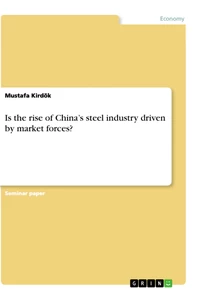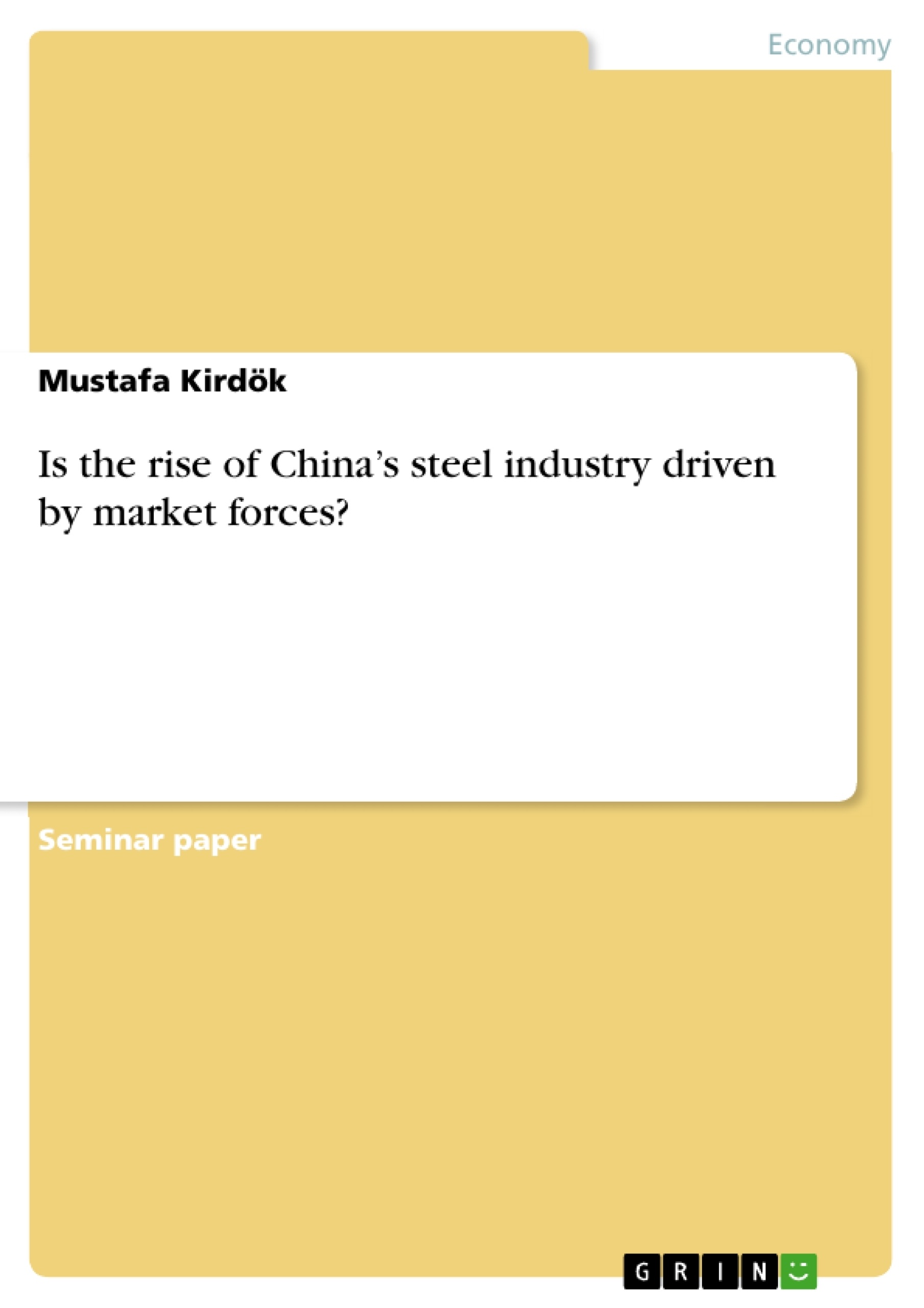Excerpt
List of Contents
List of Figures and Tables
List of Abbreviations
1 Introduction
2 The rise of China’s Steel Industry
3 Transition of China’s Economic System
3.1 Principles of market and planned economies
3.2 Entering the world market through WTO accession
4 Government Ownership of China’s Steel Industry
4.1 Involvement of Chinese Government
4.2 Subsidies to China’s Steel Industry
5 Violation of WTO obligations and absence of market forces
6 Conclusion and Outlook
Bibliography
ITM-Checklist
Executive Summary
Rise of China’s steel industry
Even though China’s industry had been weakened during the civil war from 1927 to 1949, China presently owns the world’s largest steel industry. The Communist Party gained control after the war and focused on the establishment of the steel industry. Beginning from 1978 economic reforms stimulated China’s economy. As a result, China was the fourth largest steel producer worldwide and owned the worldwide largest steel industry by 2005. In 2018, China produced nearly nine times more crude steel than the second largest crude steel producer – India.
Purpose of the assignment
This assignment examines the rise of China’s steel industry while considering the role and influence of the government and the development of the economic system. The WTO obligations hereby represent central characteristics of market forces.
Entry to the world market
The Chinese government claims that its economy transitions to a more market- based economy through economic reforms beginning from 1978 and the accession to the World Trade Organization in 2001. According to their argumentation it requires more than removing the governments control within the market. Market forces were introduced by ensuring that state-owned enter- prises are in competition with market-based enterprises.
Violation of WTO obligations
However, the Chinese government plays a significant role in the development of its steel industry. Despite its WTO obligations, the Chinese government continues on keeping ownership of the largest steel producers. These producers benefit from subsidies in form of grants and preferential bank financing. Therefore, steel producers are forced to reach governmental targets manifested in plans and policies issued by the government, rather than following market principles.
Absence of market forces
In conclusion, the growth of China’s steel industry is not based on market forces. The government maintains a high degree of decision-making authority and directs major aspects of the steel industry. As the government is in ownership of the factors of production, artificial cost advantages are generated and thus global competitors are negatively affected.
List of Figures and Tables
Figure 1: World total crude steel production in 2008 and 2018
Figure 2: Schematic draft of market and planned economies
List of Tables
Table 1: Top ten steel producers in 2018
Table 2: Comparison of WTO obligations and governmental interventions
List of Abbreviations
Abbildung in dieser Leseprobe nicht enthalten
1 Introduction
Even though China’s industry had been weakened during the civil war from 1927 to 1949, China presently owns the world’s largest steel industry. In 1949, the Chinese Communist Party gained control and invested in steel plant equipment, such as mills and furnaces. Through economic reforms and the accession to the World Trade Organization, China entered the world market. By end of the 20th century China was the fourth largest steel producer worldwide and became the world leader in 2005. Hereby the Chinese government plays a significant role, as leading steel producers in China are state-owned.
Within this assignment the role and influence of the government and the devel- opment of the economic system in China will be taken into consideration in order to examine following research question: Is the rise of China’s steel industry driven by market forces?
This assignment begins with an overview of the development of China’s steel industry. Within Chapter 2 main historical events and achievements are high- lighted. Besides, key figures are presented and compared to countries around the globe, so that the position of the Chinese steel industry is highlighted. In the following Chapter 3, two basic economic systems and the accession of China to the World Trade Organization complete the background information which are essential in regards to the research question. Thereafter, the content of Chapter 4 outlines the structure of the steel industry regarding the significance of the government and its provision of subsidies to enterprises operating for the steel business. These results are the basis for discussion in Chapter 5. In this chapter, the WTO obligations, representing central characteristics of market forces, and the compliance within China’s steel industry are analysed. In conclusion, Chapter 6 contains a summary of the findings including limitations and an outlook for further researches.
2 The rise of China’s Steel Industry
China’s Steel Industry had been weakened during the civil war, which began 1927 and ended in 1949. The Chinese Communist Party gained control and estab- lished People's Republic of China (PRC, hereafter “China”) in 1949. The new leadership focused on the establishment of the steel industry. This focus resulted in investments into new mills and blast furnaces. In 1978, China’s economy had been stimulated by market-based economic reforms. These reforms increased the average annual growth rate of around 10 per cent. During this period, the crude steel production growth rate raised simultaneously.1 By the end of the 20th century, China was the fourth largest steel producer worldwide and owned the worldwide largest steel industry by 2005.2 The following figure contains the world total crude steel production in the years 2008 and 2018. As indicated in Figure 1, the Chinese steel industry continued to grow after reaching the world leadership.
[...]
1 See Holloway J. et al., China’s Steel Industry, 2010, p.19
2 See Price A. et al., China Syndrome, 2006, p. 6
- Quote paper
- Mustafa Kirdök (Author), 2020, Is the rise of China’s steel industry driven by market forces?, Munich, GRIN Verlag, https://www.grin.com/document/542599
Publish now - it's free






















Comments